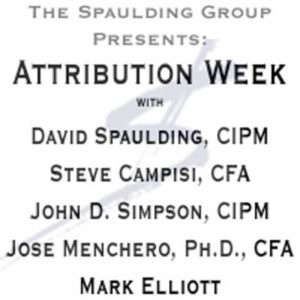Fundamentals of Performance Measurement – PLUS Virtual Training (Module 3 – Performance Attribution)
$450
Fundamentals of Performance Measurement – PLUS
Module 3 – Performance Attribution
Fundamentals of Performance Measurement - PLUS
Module 3 - Performance Attribution
Virtual learning classes, approximately 4 hours each
Module 3: Performance Attribution
Develop an appreciation and understanding of attribution.
- The class covers both absolute (contribution) and relative attribution, with most of the time spent on the latter.
- We explain why we measure attribution, and the benefits it provides
- From an equity perspective, we will discuss and contrast the two major methods (Brinson-Fachler and Brinson, Hood, Beebower). Examples will be provided so that the students understand the impact of the subtle, but significant, differences between them.
- We will discuss the interaction effect, and why some firms prefer not to include it, and how this is done, as well as its benefits.
- We will review the three “laws” of relative attribution
- We will discuss fixed income attribution, to include an explanation as to why such models are needed, by contrasting the fine points of equity and fixed income investing.
- An overview of the types of fixed income attribution models is discussed, as well as their uses, and implementation considerations.
- We will present and discuss a “Brinson-esque” fixed income model (McLaren), so students will better understand how these models can be employed to provide insights into the impact of manager decisions.
- We also cover the exposure-decomposition-based Campisi fixed income model that uses duration to help explain value added from bond manager decisions.
- We will discuss currency attribution, and review a naive approach to accomplishing it. And while we will briefly touch on Karnosky-Singer, due to time constraints we will not delve into great detail on this model.
- We will contrast arithmetic and geometric attribution, and the core differences between them, as well as their respective benefits and shortcomings.
- We will briefly contrast holdings and transaction-based attribution.
- We will explain the appropriateness of using daily vs. monthly attribution.
- We will briefly discuss the concept of multi-period attribution and touch on major approaches that can be employed to extend attribution across time. This discussion will also contrast geometric and arithmetic, and why arithmetic requires additional models to facilitate linking.





